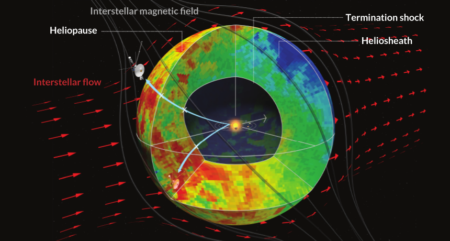July 13, 2019 – The science nerd in me had to share this piece of interesting news that is coming from observations by New Horizons, the NASA spacecraft that rendezvoused with Pluto in 2015 and with Ultima Thule on News Year Eve 2019. It appears that New Horizons has been using its UV spectrometer and telescope, called Alice, to confirm or disprove what the two Voyager spacecraft observed some 30 years ago. The Voyagers reported a scattering of light which could come about by uncharged hydrogen atoms colliding with streams of charged particles from the solar wind.
New Horizons’ observations confirmed the light scattering and presence of hydrogen atoms, described by researchers who published the results in the August 7, 2018 edition of Geophysical Research Letters.
The researchers describe interplanetary medium atomic hydrogen observations as Lyman‐α emissions, a Lyman‐α, “a possible signature of the hydrogen wall at the heliopause,” the boundary that defines the edge of local space and the beginning of interstellar space.
Determining the size and shape of this hydrogen wall is helping astronomers to define the ultimate shape of the heliosphere, the bubble that surrounds our Solar System. Is the bubble spherical or elliptical in shape with a long magnetosphere-like tail? That remains unknown. When Cassini was orbiting Saturn, the instrumentation on board was able to image the heliosphere of our Solar System over eleven years of observation. At the time it suggested a more spherical shape (see image below) and not one similar to the magnetosphere that surrounds Earth with its long comet-like tail.

The New Horizons data which continues to come in as it travels through the Kuiper Belt on its way to exit the Solar System, provides much more sensitive readings than either Cassini or the two Voyagers. It already has scanned the ultraviolet sky seven times from 2007 to 2017, and should over the next fifteen to twenty years, the estimated operational life of the robotic spacecraft, provide a far more detailed view of the hydrogen wall and its dimensions. If it notes, at some point, a drop off in the ultraviolet spectrum, it may mean New Horizons has passed through the hydrogen wall. Current observations suggest a distance of at least 100 times further out than Earth is to the Sun.















